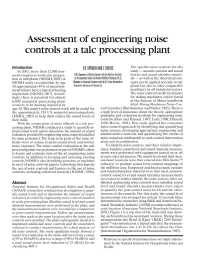Mining Publication: Assessment of Engineering Noise Controls at a Talc Processing Plant
Original creation date: April 2009
National Institute for Occupational Safety and Health (NIOSH) researchers conducted an investigation to quantify sound levels and to determine the amount of sound reduction provided by engineering noise controls installed in a talc processing plant. Baseline sound level and sound intensity measurements were performed at the plant, and the measurement locations were recorded for comparison to post-control measurements. Follow-up measurements were then made at the same locations after the initial noise controls were installed. The plant subsequently decided to implement additional noise controls and the researchers returned to conduct measurements for a final analysis of all noise controls. The most significant results showed a sound level reduction in the main mill area from a range of 93 to 104 dB(A) down to a range of 90 to 94 dB(A) and a total sound power level reduction of 21 dB(A) for air classifying Mill 3.
Authors: ER Spencer, ER Reeves
See Also
- Analysis of a Mechanism Suspension to Reduce Noise from Horizontal Vibrating Screens
- Determination of Sound Exposures (DOSES): Software Manual and Implementation Guide
- Evaluation of Stiffeners for Reducing Noise from Horizontal Vibrating Screens
- Noise and Vibration Reduction of a Vibrating Screen
- A Noise Control for A Roof Bolting Machine: Collapsible Drill Steel Enclosure
- Noise Controls for Vibrating Screen Mechanisms
- Results of Noise Measurements from Underground Testing of a Roof Bolting Machine Duty Cycle
- Structural Vibration as a Noise Source on Vibrating Screens
- Technology News 536 - NIOSH Develops New Software to Analyze and Reduce Noise Exposure
- Water Well Safety Bits: Health And Safety Information For The Water Well Industry
- Content source: National Institute for Occupational Safety and Health, Mining Program


 ShareCompartir
ShareCompartir
